Matplotlib Scatter Plot Color by Category in Python
Scatter plot are useful to analyze the data typically along two axis for a set of data. It shows the relationship between two sets of data
The data often contains multiple categorical variables and you may want to draw scatter plot with all the categories together
The coloring of each category in the scatter plot is important to visualize the relationship among different categories
In this post we will see how to color code the categories in a scatter plot using matplotlib and seaborn
Scatter Plot Color by Category using MatplotlibPermalink
Matplotlib scatter has a parameter c which allows an array-like or a list of colors. The code below defines a colors dictionary to map your Continent colors to the plotting colors.
import matplotlib.pyplot as plt
import numpy as np
import pandas as pd
population = np.random.rand(100)
Area = np.random.randint(100,600,100)
continent =['North America','Europe', 'Asia', 'Australia']*25
df = pd.DataFrame(dict(population=population, Area=Area, continent = continent))
fig, ax = plt.subplots()
colors = {'North America':'red', 'Europe':'green', 'Asia':'blue', 'Australia':'yellow'}
ax.scatter(df['population'], df['Area'], c=df['continent'].map(colors))
plt.show()
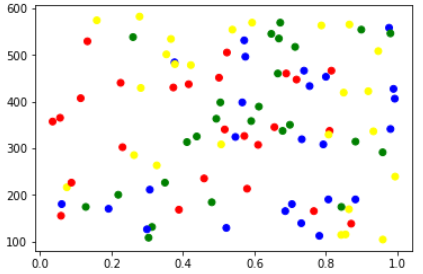
Color by Category using SeabornPermalink
Seaborn has a scatter plot that shows relationship between x and y can be shown for different subsets of the data using the hue, size, and style parameters. These parameters control what visual semantics are used to identify the different subsets
The hue parameter is used for Grouping variable that will produce points with different colors. Can be either categorical or numeric, although color mapping will behave differently in latter case.
import seaborn as sns
sns.scatterplot('population', 'Area', data=df, hue='continent')
plt.show()
Alternatively, we can also use lmplot function that combines regplot() and FacetGrid. It is intended as a convenient interface to fit regression models across conditional subsets of a dataset.
We will set the fit_reg parameter to False because we don’t want to estimate and plot a regression model relating the x and y variables
import seaborn as sns
sns.lmplot('population', 'Area', data=df, hue='continent', fit_reg=False)
plt.show()
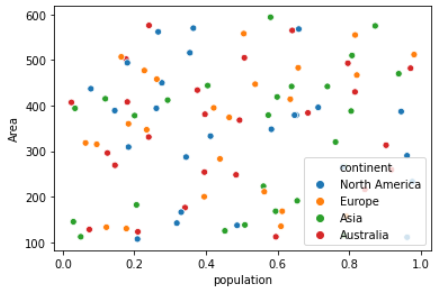
Color by Category using Pandas GroupbyPermalink
We will loop over pandas grouped object(df.groupby) and create individual scatters and manually assign colors
This code assumes the same DataFrame as above and then groups it based on color. It then iterates over these groups, plotting for each one.
To select a color I’ve created a colors dictionary which can map the Continent color (for instance North America) to a real color (for instance red).
fig, ax = plt.subplots()
colors = {'North America':'red', 'Europe':'green', 'Asia':'blue', 'Australia':'yellow'}
grouped = df.groupby('continent')
for key, group in grouped:
group.plot(ax=ax, kind='scatter', x='population', y='Area', label=key, color=colors[key])
plt.show()
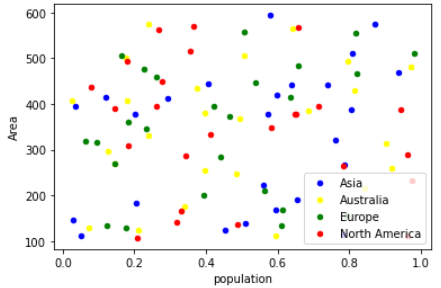
Seaborn Color PalettePermalink
This function provides an interface to many of the possible ways you can generate colors in seaborn. It return a list of colors defining a color palette.
It takes 2 parameters i.e. Name of Palette and Number of colors in the palette
We will create the color palette first
sns.palplot(sns.color_palette("muted"))

And then map this color palette with the Color Labels i.e. Unique Continents in our data set
# Get Unique continents
color_labels = df['continent'].unique()
# List of colors in the color palettes
rgb_values = sns.color_palette("Set2", 4)
# Map continents to the colors
color_map = dict(zip(color_labels, rgb_values))
# Finally use the mapped values
plt.scatter(df['population'], df['Area'], c=df['continent'].map(color_map))
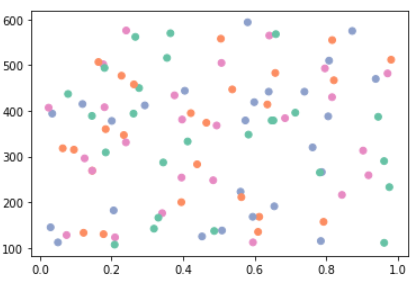
Matplotlib ColormapPermalink
Colormap instances are used to convert data values (floats) from the interval [0, 1] to the RGBA color that the respective Colormap represents
With this scatter plot we can visualize the different dimension of the data: the x,y location corresponds to Population and Area, the size of point is related to the total population and color is related to particular continent
rng = np.random.RandomState(0)
x = df['population']
y = df['Area']
colors = {'North America':'red', 'Europe':'green', 'Asia':'blue', 'Australia':'yellow'}
plt.scatter(x, y, s=100*df['population'], alpha=0.3,
c= df['continent'].map(colors),
cmap='viridis')
plt.colorbar();
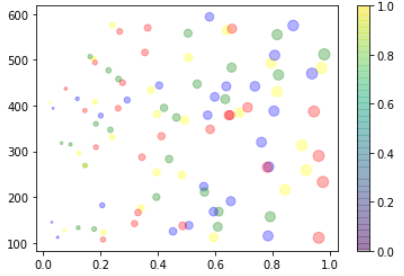
Multicolor and multifeature scatter plots like this can be useful for both exploration and presentation of data